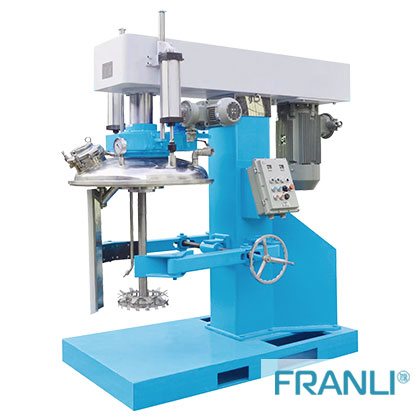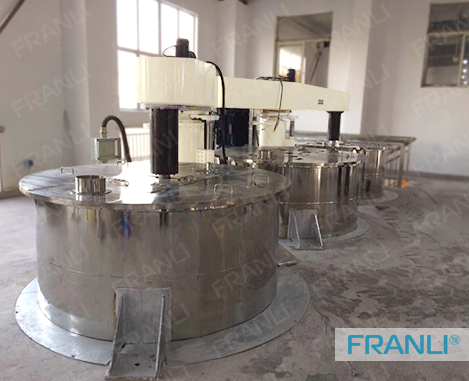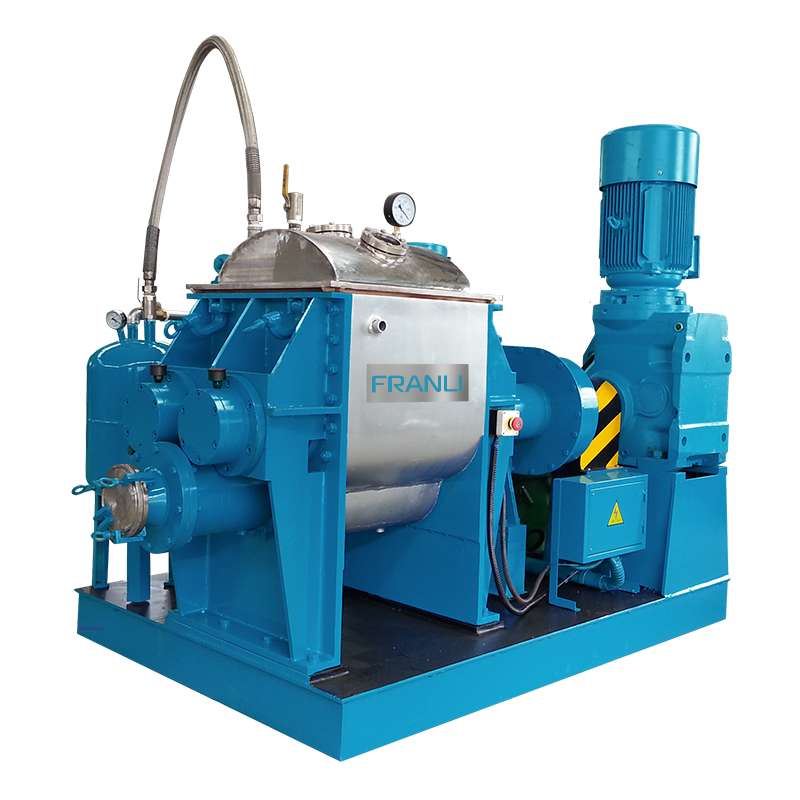Home » Application effect report of FRANLI bead mill
Application effect report of FRANLI bead mill
FRANLI as a manufacturer with more than 20 years of experience in the production and development of bead mills, our bead mills are high-efficiency wet grinding equipment, which has been used in paints, inks, pigments, paper coatings, ceramic glazes, Magnetic materials, plastic fillers, functional materials, and refractory gold mines and other industries.
All bead mills were originally developed and designed with inspiration from ball mills. A Bead mill, also known as a sand mill, is one of the best machines for wet ultrafine grinding equipment. It is characterized by the high processing efficiency of materials and wide practicability of materials. In general, bead mills are divided into horizontal bead mills and vertical bead mills, and the bead mills produced by FRANLI have higher performance.
Working principle of bead mill
The bead mill is a horizontal wet continuous production grinding and dispersing machine. The pre-stirred raw materials are sent into the grinding tank of the main machine, and the grinding tank is filled with an appropriate amount of grinding medium. The high-speed rotation of the dispersing blade gives the grinding medium enough kinetic energy to collide with the dispersed material particles to generate shearing and crushing force and extrusion. Press the crushing force to achieve the effect of dispersion, and then through a special separation device, the dispersed material and the grinding media are separated and discharged.
Development of bead mill
According to the development of the bead mill, it can be divided into five stages: vertical stirring mill, vertical disc bead mill, vertical pin bead mill, horizontal disc bead mill, and horizontal pin circulation bead mill.
The grinding process of bead mill
There is four main grinding process flow of bead mill, namely continuous grinding process, series grinding process, combined cycle grinding process, and single barrel cycle grinding process. The premise of the single barrel circulating grinding process is that the number of cycles is greater than 5, and the circulating barrel is equipped with a stirrer to ensure that the materials are fully mixed and avoid dead spots in the circulating barrel. The process is simple in operation and low in equipment investment and is generally used for the grinding of ceramic raw materials, such as silicon carbide, silicon nitride, boron carbide, etc.
Application of bead mill
◆ Bead mill for Ceramic ink
Ceramic ink is the core of ceramic inkjet printing technology. Its composition and performance are adjusted to meet the decorative effect and the working principle of the printer, and at the same time, it needs to meet the properties of stable physical and chemical properties and storage stability.
During the grinding process of ceramic ink, the material particles are crushed to a certain particle size by the sheer force and extrusion force between the grinding media to achieve the effect of dispersion. The stirring shaft of the bead mill rotates the material and the grinding medium to avoid the dead angle of grinding so that the material can be mixed more evenly.
◆ Bead mill for Titanium dioxide
Sand grinding is a key process in the crushing of primary titanium dioxide products in titanium dioxide enterprises. Only after the crushing process can the primary products of titanium dioxide be located in a certain particle size range, to carry out inorganic and organic coating treatment, reflecting its good pigment performance. To achieve the best sanding effect of the bead mill, it is necessary to adjust the process parameters according to the specific material conditions. The process parameters mainly include sand grinding speed, feeding speed, the particle size of zirconium beads, medium filling rate, and feeding concentration. Whiteness and water dispersibility are the key performance indicators of titanium dioxide pigments. Therefore, it is of great significance to study the effect of different particle sizes of slurry on its whiteness and water dispersibility.
◆ Bead mill for Painting
The bead mill used in the coating industry can be traced back to the 1970s. The vertical closed bead mill was introduced in China. The domestic model was successfully developed in the 1980s, and then a series of products were gradually formed. It was a breakthrough for the paint industry at the time. At the same time, it was widely used in paint enterprises and became the main equipment for grinding and dispersing in the paint industry at that time.
Recently, with the gradual expansion of the application of bead mills, the technical improvement of equipment has gradually increased, and the application of secondary energy-efficient energy-saving motors and frequency conversion technology in bead mills has been vigorously promoted, and PLC automatic control systems have been applied to the print production process. It greatly improves production efficiency, reduces energy consumption, saves labor costs, and reduces pollutant emissions, providing a new development opportunity for Chinese paint companies to go global. Since 1952, it has been widely used in the pigment and paint industry. About 70% to 80% of the paint products in China are completed by the bead mill, and later entered the field of pesticide processing.
◆ Bead mill for Ink
Dispersion grinding is an important part of the coating and ink production process. In the article “Application of Bead Mill in Dispersion and Grinding of Solvent and Water-based Ink”, Liu Caosheng et al. studied the application of bead mill in the dispersion and grinding of solvent and water-based ink. It mainly tests the effects of different stirring shaft speeds of the same type of bead mill, different grinding media (specific gravity, diameter, etc.), different cooling water temperatures, and different grinding methods (pass grinding and cyclic grinding) on the grinding effect, as well as different types of bead mills. The grinding effect of the machine. It was found in the experiment that the M5 nano-bead mill was used for one-pass grinding, the linear speed of the grinding rotor was 18m/s, the time was set to 5h, the grinding medium was tungsten carbide, and the cooling water temperature was 10 ℃, which was solvent and water-based ink. Optimum conditions for dispersive grinding.
◆ Production of pesticides and suspending agents
Horizontal bead mills are widely used at home and abroad to produce pesticide suspending agent products; closed horizontal bead mills can nearly double the capacity of vertical bead mills, with low driving power and low energy consumption, and are more favored by users.
In the processing of suspending agent, the bead mill is the most important equipment in the dispersing process, and its main function is to disperse the solid particles of pesticides in the liquid medium (water). The general sanding function consists of three stages:
(1) Wetting, that is, the gas adsorbed on the surface of the pesticide solid particles is replaced by the liquid.
(2) Grinding, grinding large particles into small particles, and at the same time crushing the agglomerated particles into original particles by mechanical force.
(3) Dispersion, moving the wetted original particles into the liquid medium (suspended in the liquid) to produce lasting particle separation.
Practice and experience show that it usually takes 2~3 times of grinding, and the average particle size of the material can reach 2~3μm. The specific operation method is to use multiple bead mills in series. The particle size of the grinding media used in the barrel of each bead mill can be the same or different; Coarse to fine.
◆ Wet crushing of lead zirconate titanate
Introduced the equipment structure of a new type of bead mill and the working principle of the bead mill pulverization method in the article “The application of the bead mill method in the wet grinding of lead zirconate titanate”. The bead mill pulverization method was applied to the wet pulverization of lead zirconate titanate powder, and the ultrafine powder with the average particle size d50 of less than 0.45μm was obtained. The industrial production test of ultrafine pulverization of lead zirconate titanate powder proves that the bead mill pulverization method can be applied to the ultrafine pulverization process of the ceramic material industry.
In addition, bead mills have many applications in electronic ceramic slurry, new energy material processing, mineral powder, and other fields.
Copyright Notice :
This article only represents the author’s point of view.
This article is published under the authorization of the author.
Source: Franli
This article address : Application effect report of FRANLI bead mill
Related Products

Twin Shaft Disperser
The Twin Shaft Disperser is composed of two sets of mixing devices. Different mixing devices can be designed according to different materials.

Platform Type High Speed Disperser
Platform type high-speed disperser is mainly used for high production material. Normally the high-speed disperser is installed between two tanks, easily mixing material in two tanks. also another type.

Vacuum Kneader
The vacuum kneader is an ideal equipment that is suitable for high-viscosity material, such as high-viscosity silicone rubber, sealant, gum, cellulose, etc. Also used widely in the Paint, ink, pigment, resin, battery, cosmetic, etc industries.
News
Laboratory Reactor: Guide to Stirring System
The laboratory reactor is composed of a pot body, a pot cover, an agitator, a jacket, a support and transmission device, a shaft seal device, etc.
Grinding Media for Bead Mill | Zirconia Beads & Zirconium Silicate Beads
Bead mills mainly use grinding balls as media, and use impact, extrusion, and friction to achieve the final grinding effect, which mainly depends on the size and hardness of the grinding beads, the filling rate of the grinding beads, and the collision frequency adjustment between the grinding beads and the particles.
Overview of Laboratory Reactor
Laboratory reactors, also known as lab reactors, are essential tools in scientific research, product development, and process optimization. These reactors provide a controlled environment for conducting chemical reactions, mixing, dispersing, and homogenizing processes.
Bead mills | Manufacturing technology in various industries
Bead mills, also known as sand mills or grinding mills, are versatile machines widely used across various industries for the wet grinding and dispersion of solid particles in liquid media.
Ribbon Blender Mixer Equipment
A ribbon blender mixer, also known as a ribbon mixer or horizontal ribbon blender, is a powerful industrial machine designed for thorough and efficient blending of various materials.
What is A Stainless Steel Reactor?
Stainless steel reactors are essential equipment in various industries, including chemical, pharmaceutical, biotechnology, and food processing.
